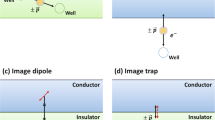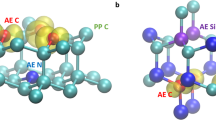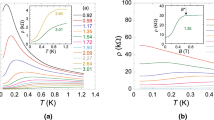Abstract
Using the spin of the electron to carry information, instead of or in addition to its charge, could provide advances in the capabilities of microelectronics. Successful implementation of spin-based electronics requires preservation of the electron spin coherence. In n-doped semiconductors, long spin-coherence times have been observed, with a maximum at a ‘magic’ electron density. Here, we vary the density in a two-dimensional electron gas, and show that spin coherence is lost because of the interplay between localization by disorder and dynamical scattering. By measuring the electron Landé g-factor dependence on density, we determine the density of states (DOS), which characterizes the disorder potential. Using our knowledge of the DOS, a simple model estimates the temperature and excitation intensity dependence of the g factor, qualitatively agreeing with experiments. This agreement confirms the importance of disorder and provides predictive power for designing spin-based electronic devices.
This is a preview of subscription content, access via your institution
Access options
Subscribe to this journal
Receive 12 print issues and online access
$209.00 per year
only $17.42 per issue
Buy this article
- Purchase on Springer Link
- Instant access to full article PDF
Prices may be subject to local taxes which are calculated during checkout




Similar content being viewed by others
References
Wolf, S. A. et al. Spintronics: a spin-based electronics vision for the future. Science 294, 1488–1495 (2001).
Kikkawa, J. M. & Awschalom, D. D. Resonant spin amplification in n-type GaAs. Phys. Rev. Lett. 80, 4313–4316 (1998).
Kikkawa, J. M., Smorchkova, I. P., Samarth, N. & Awschalom, D. D. Room-temperature spin memory in two-dimensional electron gases. Science 277, 1284–1287 (1997).
Dzhioev, R. I. et al. Low-temperature spin relaxation in n-type GaAs. Phys. Rev. B 66, 245204 (2002).
Sandhu, J. S., Heberle, A. P., Baumberg, J. J. & Cleaver, J. R. A. Gateable suppression of spin relaxation in semiconductors. Phys. Rev. Lett. 86, 2150–2153 (2001).
Furis, M., Smith, D. L., Crooker, S. A. & Reno, J. L. Bias-dependent electron spin lifetimes in n-GaAs and the role of donor impact ionization. Appl. Phys. Lett. 89, 102102 (2006).
Hoffmann, H. et al. Optical spin pumping of modulation-doped electrons probed by a two-color Kerr rotation technique. Phys. Rev. B 74, 073407 (2006).
Salis, G. et al. Electrical control of spin coherence in semiconductor nanostructures. Nature 414, 619–622 (2001).
Maude, D. K. et al. Spin excitations of a two-dimensional electron gas in the limit of vanishing Landé g factor. Phys. Rev. Lett. 77, 4604–4607 (1996).
Ivchenko, E. L., Kiselev, A. A. & Willander, M. Electronic g factor in biased quantum wells. Solid State Commun. 102, 375–378 (1997).
Snelling, M. J. et al. Magnetic g factor of electrons in GaAs/AlxGa1−xAs quantum wells. Phys. Rev. B 44, 11345–11352 (1991).
Sirenko, A. A. et al. Electron and hole g factors measured by spin-flip Raman scattering in CdTe/Cd1−xMgxTe single quantum wells. Phys. Rev. B 56, 2114–2119 (1997).
Stein, D., Klitzing, K. v. & Weimann, G. Electron spin resonance on GaAs–AlxGa1−xAs heterostructures. Phys. Rev. Lett. 51, 130–133 (1983).
Yang, M. J., Wagner, R. J., Shanabrook, B. V., Waterman, J. R. & Moore, W. J. Spin-resolved cyclotron resonance in InAs quantum wells: A study of the energy-dependent g factor. Phys. Rev. B 47, 6807–6810 (1993).
Dawson, P. & Godfrey, M. J. Recombination dynamics of spatially separated electron-hole plasmas in GaAs/AlAs mixed type-I/type-II quantum well structures. Phys. Rev. B 68, 115326 (2003).
Crooker, S. A., Awschalom, D. D., Baumberg, J. J., Flack, F. & Samarth, N. Optical spin resonance and transverse spin relaxation in magnetic semiconductor quantum wells. Phys. Rev. B 56, 7574–7588 (1997).
Chen, Z., Bratschitsch, R. & Cundiff, S. T. Interference effects in transient Kerr spectra of a semiconductor multilayer structure. Opt. Lett. 30, 2320–2322 (2005).
Amand, T. et al. Spin quantum beats of 2D excitons. Phys. Rev. Lett. 78, 1355–1358 (1997).
Malinowski, A. & Harley, R. T. Anisotropy of the electron g factor in lattice-matched and strained-layer III-V quantum wells. Phys. Rev. B 62, 2051–2056 (2000).
Yeo, T., McCombe, B. D., Ashkinadze, B. M. & Pfeiffer, L. Metal-insulator transition of spatially separated electrons and holes in mixed type I-type II GaAs/AlAs quantum wells. Physica E 12, 620–623 (2002).
Hermann, C. & Weisbuch, C. perturbation theory in III-V compounds and alloys: a reexamination. Phys. Rev. B 15, 823–833 (1977).
D’yakonov, M. I. & Perel’, V. I. Spin orientation of electrons associated with the interband absorption of light in semiconductors. Zh. Eksp. Teor. Fiz. 60, 1954–1965 (1971).
Oestreich, M. & Ruhle, W. W. Temperature dependence of the electron Landé g factor in GaAs. Phys. Rev. Lett. 74, 2315–2318 (1995).
Carter, S. G., Chen, Z. & Cundiff, S. T. Optical measurement and control of spin diffusion in n-doped GaAs quantum wells. Phys. Rev. Lett. 97, 136602 (2006).
Dobers, M., Klitzing, K. v. & Weimann, G. Electron-spin resonance in the two-dimensional electron gas of GaAs–AlxGa1−xAs heterostructures. Phys. Rev. B 38, 5453–5456 (1988).
Acknowledgements
We acknowledge support from NSF. S.G.C. is supported by a National Research Council Postdoctoral Fellowship.
Author information
Authors and Affiliations
Corresponding author
Ethics declarations
Competing interests
The authors declare no competing financial interests.
Supplementary information
Rights and permissions
About this article
Cite this article
Chen, Z., Carter, S., Bratschitsch, R. et al. Effects of disorder on electron spin dynamics in a semiconductor quantum well. Nature Phys 3, 265–269 (2007). https://doi.org/10.1038/nphys537
Received:
Accepted:
Published:
Issue Date:
DOI: https://doi.org/10.1038/nphys537
This article is cited by
-
Spin memory of the topological material under strong disorder
npj Quantum Materials (2020)
-
Magnetic field effects in hybrid perovskite devices
Nature Physics (2015)



